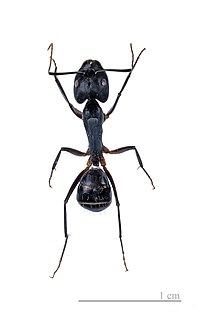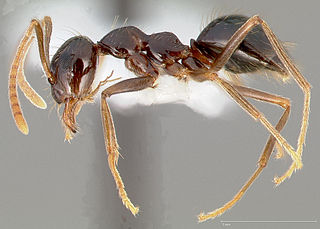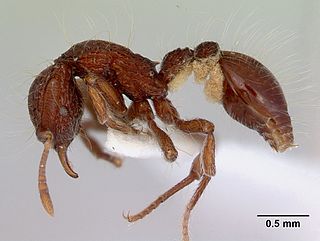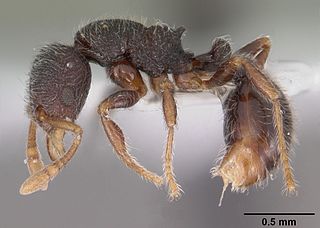
The Formicinae are a subfamily within the Formicidae containing ants of moderate evolutionary development.
Dicistroviridae is a family of viruses in the order Picornavirales. Invertebrates, including aphids, leafhoppers, flies, bees, ants, and silkworms, serve as natural hosts. There are currently 15 species in this family, divided among 2 genera. Diseases associated with this family include: DCV: increased reproductive potential. extremely pathogenic when injected with high associated mortality. CrPV: paralysis and death.

The Pyraloidea are a moth superfamily containing about 16,000 described species worldwide, and probably at least as many more remain to be described. They are generally fairly small moths.

Myrmarachne is a genus of ant-mimicking jumping spiders that was first described by W. S. MacLeay in 1839. They are commonly called antmimicking spiders, but they are not the only spiders that have this attribute. The name is a combination of Ancient Greek μύρμηξ (myrmex), meaning "ant", and ἀράχνη (arachne), meaning "spider".

Nepenthes ampullaria is a very distinctive and widespread species of tropical pitcher plant, present in Borneo, the Maluku Islands, New Guinea, Peninsular Malaysia, Singapore, Sumatra, and Thailand.

Nepenthes gracilis, or the slender pitcher-plant, is a common lowland pitcher plant that is widespread in the Sunda region. It has been recorded from Borneo, Cambodia, Peninsular Malaysia, Singapore, Sulawesi, Sumatra, and Thailand. The species has a wide altitudinal distribution of 0 to 1100 m above sea level, although most populations are found below 100 m and plants are rare above 1000 m. Despite being a widespread plant, natural hybrids between N. gracilis and other species are quite rare.

Nepenthes bicalcarata, also known as the fanged pitcher-plant, is a tropical pitcher plant endemic to northwestern Borneo, Indonesia. It is a myrmecophyte noted for its mutualistic association with a species of ant, Camponotus schmitzi. As an ant-fed plant it lacks many of the features that characterise the carnivorous syndrome in Nepenthes, including viscoelastic and highly alkaline pitcher fluid, the waxy zone of the pitcher interior, and possibly even functional digestive enzymes.

Nepenthes veitchii, or Veitch's pitcher-plant, is a Nepenthes species from the island of Borneo. The plant is widespread in north-western Borneo and can also be found in parts of Kalimantan. Nepenthes veitchii usually grows as an epiphyte, though the form from Bario seems to be strictly terrestrial and has not been observed to climb trees.
Dr. Charles M. Clarke is an ecologist and botanist specialising in the carnivorous plant genus Nepenthes, for which he is regarded as a World Authority. Clarke has an honours degree in Botany from Monash University in Melbourne, and a Ph.D. in Ecosystem management at the University of New England, in Armidale, New South Wales.

Plagiolepidini are an ant tribe from the subfamily Formicinae.

Dinomyrmex is a monotypic genus of ant containing the species Dinomyrmex gigas or giant forest ant. D. gigas is a large species of ant, native to Southeast Asian forests. It is one of the largest ants in existence, measuring in at 20.9 mm (0.82 in) for normal workers, and 28.1 mm (1.11 in) for the soldiers. Honeydew makes up 90% of their diet, but they will also consume insects and bird droppings. The ant is an effective forager, utilizing both efficient communication and recruitment. A handful of these ants may meet at night to engage in what has been observed to be ritual battle. These fights can continue for several months.

Myrmoteras is a genus of ants in the subfamily Formicinae and the sole member of the tribe Myrmoteratini. They have enormous eyes, a character found in other ancient genera, and extremely elongated mandibles with eight to 16 teeth. These work as trap-jaws and can open up to 270°.
Korthalsia is a clustering genus of flowering plant in the palm family spread throughout Southeast Asia. It is a highly specialized rattan with some species known to have an intimate relationship with ants, hence the common name ant rattan. High-climbing and armed with spines, the genus is named for the Dutch botanist P. W. Korthals who first collected them from Indonesia.

Aenictus is a large army ant genus distributed in the Old World tropics and subtropics. It contains about 181 species, making it one of the larger ant genera of the world.
Iflaviridae is a family of positive sense RNA viruses insect-infecting viruses. Some of the insects commonly infected by iflaviruses include aphids, leafhoppers, flies, bees, ants, silkworms and wasps. The name "Ifla" is derived from the name "Infectious flacherie virus", for the type species. There is only one genus (Iflavirus) and 14 species in this family, including the type species Infectious flacherie virus.

Dacetinops is a genus of ants in the subfamily Myrmicinae. Its seven species are known from Borneo, and Papua New Guinea. One species, D. cirrosus, is known also from Terengganu and Johor, West Malaysia.

Lasiomyrma is a South-East Asian genus of ants in the subfamily Myrmicinae. The genus is mainly known from tropical rainforests in Sundaland.

Proatta is a Southeast Asian genus of ants in the subfamily Myrmicinae. It contains the single species Proatta butteli, known from the Malay Peninsula, Borneo and Sumatra.
Ishakidris is a genus of ants in the subfamily Myrmicinae containing the single species Ishakidris ascitaspis. The genus is known only from a single worker collected in 1978 from the leaf litter in the Gunung Mulu National Park, Sarawak, Malaysian Borneo.















